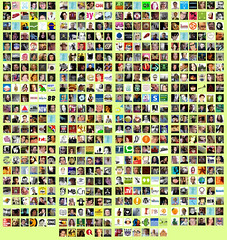According to new data from the Bureau of Labor Statistics, in 2007 the ratio of women’s and men’s median annual earnings reached almost 78 cents on the dollar for full-time year-round workers, up from just under 77 cents in 2006. This is the narrowest the wage gap has ever been, but it’s only an additional one cent on the dollar. One cent is chump change. It isn’t real change.
— from AAUW’s Equal Pay Day, April 28
African-American women earn 62¢ and Latinas earn 53¢ for every dollar earned by white, non-Hispanic men. #fairpay #fem2 #p2
— @NWLC on Twitter
One of President Obama’s first actions in late January was signing the Lilly Ledbetter Fair Pay Act into law. That’s only a first step, though; the next battle in the fight against wage discrimination is the Paycheck Fairness Act. The PFA updates the 45-year-old Equal Pay Act in many important ways, and passed the House with strong bipartisan support, and is currently before the Senate as S.182.
The AAUW’s site has a bunch of ways you can help: call your Senators, wear red,* blog about it, share on Facebook and join their group and cause, and tweet about it using the #fairpay hashtag. It’s all important; do as much as you can. There are a couple of things I’d specifically like to highlight.
Let’s start with Twitter, where this is another great opportunity for hashtag-based diversity activism. Activity via #fairpay accomplishes several things. Most obviously, it raises awareness: whenever you tweet, all your followers are reminded of the wage gap. If some of the Twitterati start retweeting, or there’s enough activity that #fairpay winds up in the top 10 “trending” hashtags, a lot more people will see it. So tweet away! If you’re not sure what to say, the National Women’s Law Center has some tweeting points you can use as inspiration.
 Even more importantly, people interested in gender equity can find each other via #fairpay, make connections, exchange information, and start working together on this and future projects. Equal Pay Day has already benefited from a similar dynamic via the #fem2 hashtag: the Sunday night Twittercast helped get people up to speed on the issue, resources, and talking points — and generated ideas for more effective activism.**
Even more importantly, people interested in gender equity can find each other via #fairpay, make connections, exchange information, and start working together on this and future projects. Equal Pay Day has already benefited from a similar dynamic via the #fem2 hashtag: the Sunday night Twittercast helped get people up to speed on the issue, resources, and talking points — and generated ideas for more effective activism.**
However there are plenty of people interested in fair pay for women who don’t identify as feminists, or don’t know about #fem2. The issue-oriented and inclusive nature of #fairplay is a valuable complement to hashtags like #fem2, #woc, #sgp, and #p2.
Tweeting doesn’t substitute for other ways of getting involved … but that’s okay: it takes very little time (a lot less than a blog post, for example) and it’s something anybody can do. So what are you waiting for?
Looking beyond Equal Pay Day, if you haven’t already read Linda Babcock and Sara Laschever’s Women don’t ask, Ask for it, or similar books about the effect of gender differences in negotiating styles, you should. Even more importantly, make sure that women you know are aware of the underlying dynamic: in general, men are more likely than women to try to negotiate a higher salary. Of course, this is far from the only factor; the structural discrimination issues addressed by the Lilly Ledbetter and Paycheck Fairness acts are critically important as well. And especially in the current tough economic climate, negotiation options are limited.
Still, this kind of empowering information can make a big difference. Back when I was at Microsoft, the stated policy for new college hires was that the company wouldn’t negotiate salary and stock. However, what nobody told the new hires was that if they pushed back there was often some flexibility in relocation packages … and if there was an offer from a competitive company like Google or Amazon, gee, it sometimes turned out that salary was negotiable after all.
If women don’t negotiate this as aggressively as men, they’re at a disadvantage from the get-go — and differences in initial salaries tend to be reflected in career earning potential. So I made it a point to recommend Women don’t ask to every female intern I met. Wouldn’t it be great if everybody at Microsoft and other companies did the same, and so did professors and mentors?
Again, this isn’t a substitute for other things you can do … but it’s easy enough, takes virtually no time, and can really help.
So please, get involved — on Twitter and elsewhere, today and in the future — and let’s help create some real change.
jon
* which is why my blog’s colors are temporarily red instead of their usual blue or pink
** In fact the tweeting points came about because I mentioned that this approach had been useful for other campaigns.
Image: The People I Follow On Twitter (June 18, 2007), CC Chapman
licensed under Creative Commons
Leave a Reply